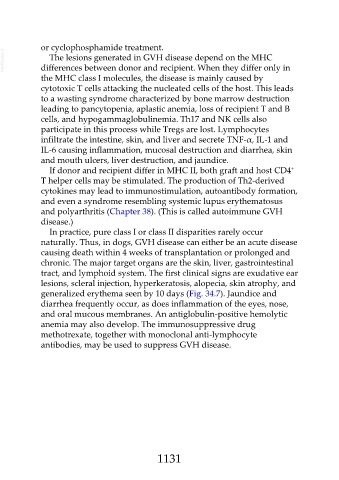Page 1131 - Veterinary Immunology, 10th Edition
P. 1131
or cyclophosphamide treatment.
VetBooks.ir differences between donor and recipient. When they differ only in
The lesions generated in GVH disease depend on the MHC
the MHC class I molecules, the disease is mainly caused by
cytotoxic T cells attacking the nucleated cells of the host. This leads
to a wasting syndrome characterized by bone marrow destruction
leading to pancytopenia, aplastic anemia, loss of recipient T and B
cells, and hypogammaglobulinemia. Th17 and NK cells also
participate in this process while Tregs are lost. Lymphocytes
infiltrate the intestine, skin, and liver and secrete TNF-α, IL-1 and
IL-6 causing inflammation, mucosal destruction and diarrhea, skin
and mouth ulcers, liver destruction, and jaundice.
If donor and recipient differ in MHC II, both graft and host CD4 +
T helper cells may be stimulated. The production of Th2-derived
cytokines may lead to immunostimulation, autoantibody formation,
and even a syndrome resembling systemic lupus erythematosus
and polyarthritis (Chapter 38). (This is called autoimmune GVH
disease.)
In practice, pure class I or class II disparities rarely occur
naturally. Thus, in dogs, GVH disease can either be an acute disease
causing death within 4 weeks of transplantation or prolonged and
chronic. The major target organs are the skin, liver, gastrointestinal
tract, and lymphoid system. The first clinical signs are exudative ear
lesions, scleral injection, hyperkeratosis, alopecia, skin atrophy, and
generalized erythema seen by 10 days (Fig. 34.7). Jaundice and
diarrhea frequently occur, as does inflammation of the eyes, nose,
and oral mucous membranes. An antiglobulin-positive hemolytic
anemia may also develop. The immunosuppressive drug
methotrexate, together with monoclonal anti-lymphocyte
antibodies, may be used to suppress GVH disease.
1131

